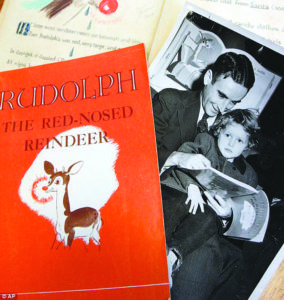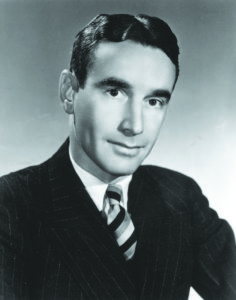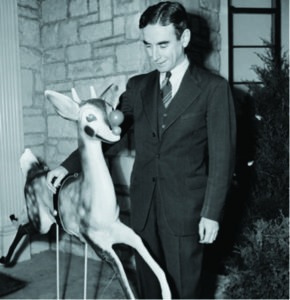
Rudolph, the Red-Nosed Reindeer,” popularly known as “Santa’s ninth reindeer,” is usually depicted as a young calf with a glowing red nose who barely has antlers. He is the lead reindeer pulling Santa’s sleigh on Christmas Eve. The luminosity of his nose is so great that it illuminates the team’s path through even the worst winter weather.


If you’ve ever read the poem “The Night Before Christmas,” you might notice that Rudolph, “the most famous reindeer of them all,” is missing. While the other reindeer were first named in that poem in 1822, Rudolph did not make his debut until 1939, when major retailer Montgomery Ward was looking to save a bit of money. Every year they bought coloring books to give away to kids in their stores, but, in 1939, they decided to create a storybook in-house. They put Robert L. May, an “in-house” advertising copywriter and the father-of-a-four-year-old-daughter, in charge of it; and he churned out the story we all know today.
After his wife’s death from cancer, May writes, his boss at Montgomery Ward took pity on him and told him to just turn in what he had already done on the proposed Christmas booklet and not work on it anymore.

However, May rejected his boss’s suggestion that he quit. May wrote in 1975: “I needed Rudolph now more than ever. Gratefully, I buried myself in the writing. Finally, in late August [1939] it was done. I called Barbara and her grandparents into the living room and read it to them. In their eyes, I could see that the story accomplished what I hoped.”
An Associated Press article from 1948 describes how the story developed.
“Working at home and in his spare time at the office — 50 hours in all — May put the story into rhyme. After he finished each part, he read it to his daughter, Barbara. ‘She was my guinea pig,’ May said, ‘I ran the words by her.’”
Montgomery Ward gave credit to May and the Rudolph story illustrator, Denver Gillen, when it issued May’s Rudolph booklet during the 1939 Christmas holiday season. But, May got no substantial bonus, even though the booklet was enormously popular. To satisfy shopper demand, Ward gave out 2.4 million booklets. Wartime restrictions on paper use prevented Ward from re-issuing Rudolph until 1946. The 1946 re-issue numbered 3.6 million copies.
Then a miracle happened for May and his family. In late 1946 or early 1947, the head of Montgomery Ward, Sewell Avery, a hard nosed businessman, gave the rights to the Rudolph poem to Robert May, free and clear. It was the first time Montgomery Ward had ever done this.
May’s brother-in-law, Johnny Marks, adapted the story of Rudolph into a song. Gene Autry’s recording hit No. 1 on the Billboard pop singles chart the week of Christmas, 1949. Autry’s recording sold 2.5 million copies the first year, eventually selling a total of 25 million, and it remained the second best-selling record of all time until the 1980’s.
The story is currently owned by The Rudolph Company, LP and has been adapted in numerous forms including Mark’s popular song, the iconic television special and sequels, and a feature film and sequel.
In many countries, Rudolph has become a figure of Christmas folklore. 2014 marked the 75th anniversary of the character and the 50th anniversary of the television special. A series of postage stamps featuring Rudolph was issued by the United States Postal Service on November 6, 2014.
No Comments
Leave a comment Cancel